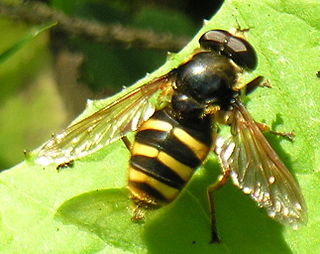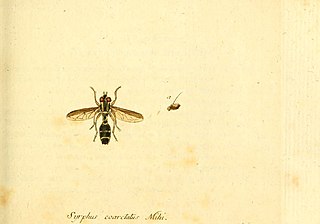
Xylota sylvarum is a common Palearctic species of hoverfly.

Platycheirus clypeatus is a species of hoverfly. It is found across the Palearctic and in the Nearctic. The larvae feed on aphids. Adults are usually found on the edges of woodland or scrub, heath or along hedgerows where they visit a wide range of flowers.

Xanthandrus comtus is a species of hoverfly. It is found in the Palearctic.

Sericomyia silentis, is a species of hoverfly. It is widespread throughout the Palearctic but normally encountered in small numbers in mountain regions and moorland and bog locations.

Sericomyia lappona, is a species of hoverfly. It is widespread throughout the Palearctic.

Platycheirus rosarum is a species of hoverfly found in the Palearctic. Like its close relative Platycheirus granditarsus, it can be found in marshy meadows and ditches; indeed, the two species can often be found together. The flight time is between May and October, though it peaks in abundance in June and July.

Pipiza bimaculata is a species of hoverfly, from the family Syrphidae, in the order Diptera.

Pipizella viduata is a species of Hoverfly, from the family Syrphidae, in the order Diptera.

Parasyrphus lineolus is a Holarctic species of hoverfly.

Parasyrphus vittiger is a species of hoverfly, from the family Syrphidae, in the order Diptera.
Parasyrphus malinellus is a species of hoverfly, from the family Syrphidae, in the order Diptera.

Parhelophilus consimilis is a Palearctic hoverfly.

Trichopsomyia flavitarsis is a European species of hoverfly.

Doros profuges is a Palearctic species of hoverfly.

Cheilosia antiqua is a European species of hoverfly.

Xylota abiens is a European species of hoverfly.

Xylota tarda is a Palearctic species of hoverfly.
Xylota florum is a Palearctic species of hoverfly.

Sphegina clunipes is a Palearctic species of hoverfly.
Neoascia geniculata is a Palearctic species of hoverfly.


















